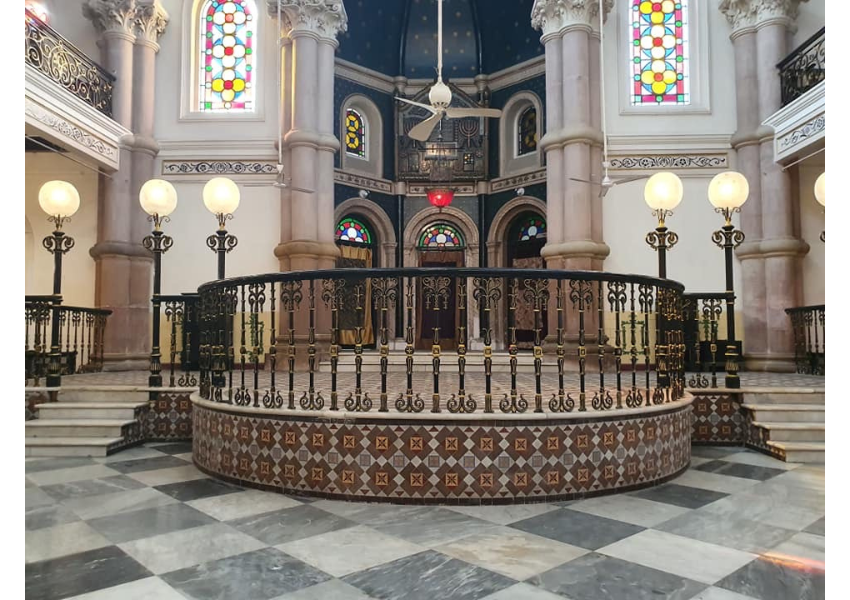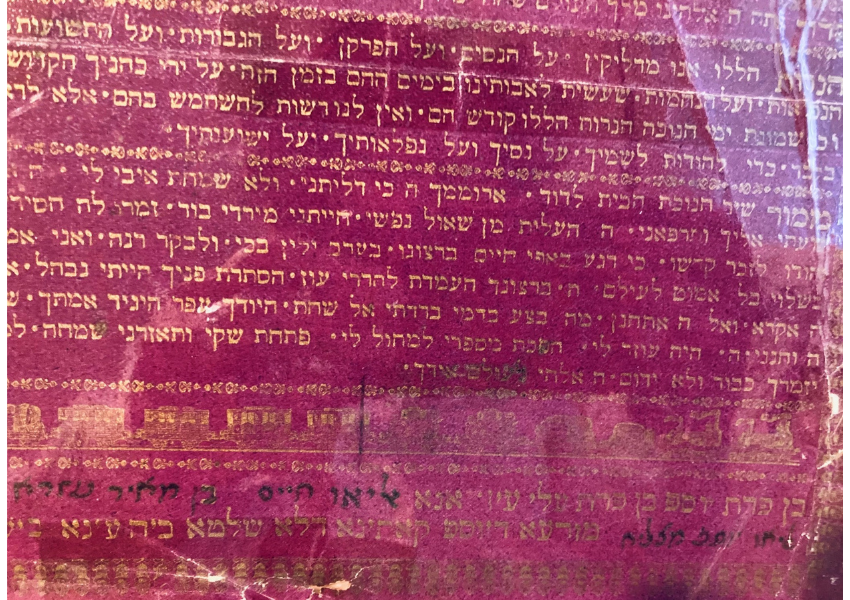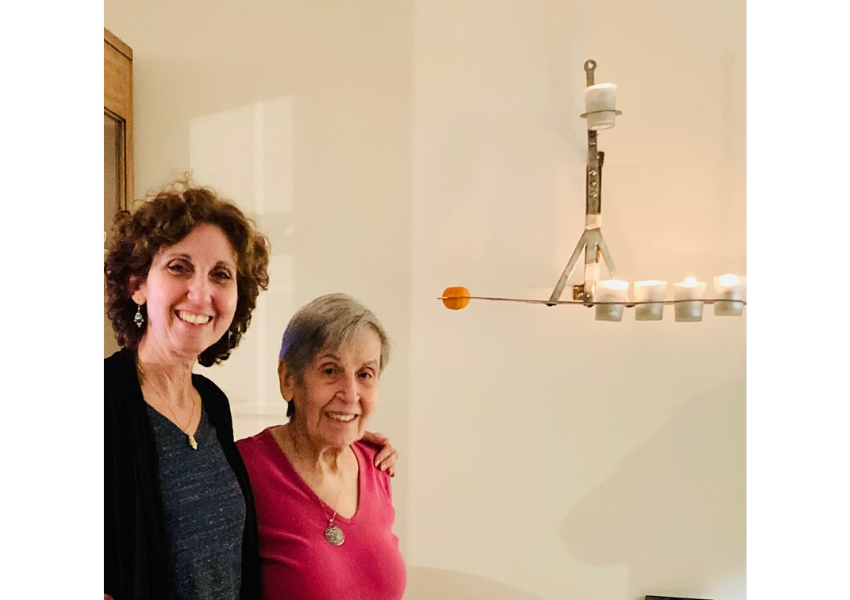Beyond Dreidels and Latkes: Hanukkah in India Is Very Different (Recipe Included!)
Indian cuisine, famous for crisp fried specialties, serve as reminders of the miracle of the oil
Published Nov 8, 2022

Musleah's family hanukkiah from India
Imagine that it’s Hanukkah— but there are no latkes on the table, no jelly donuts, gelt, or gifts. There are no dreidels in vivid colors ready to be spun or piles of pennies and peanuts for payment. “I Have a Little Dreidel” is as foreign as “Jana Gana Mana”, India’s national anthem. There aren’t even spindly, rainbow-hued candles waiting to be placed in the hanukkiah.
Hanukkah in India is celebrated far differently than it is in the United States or in Israel today. But the meaning of Hanukkah has a deep resonance in the Indian Jewish communities because India is, in fact, also the site of great miracles and a refuge for Jews all over the world.

Calcutta’s Maghen David Synagogue
The history of the Jews of India is a story of faith and refuge, survival and identity. There was never any indigenous antisemitism in India, so we lived alongside our neighbors in harmony and freedom.
The Bene Israel Jews of Bombay (Mumbai) say that they arrived in India fleeing the Hellenist persecution that caused the Maccabees to rebel. According to their tradition, they were shipwrecked off the coast of Bombay. Only seven couples survived. But as they integrated into the village communities along the coast, they held onto the faith and customs they remembered: circumcision, kashrut, refraining from working on Shabbat and reciting Shema Yisrael at every auspicious occasion.
Cochin, in south India, may be the most ancient Jewish settlement, with trade routes to and from the land of Israel as far back as the time of King Solomon. During the Inquisition, Spanish and Portuguese Jews found refuge in Cochin under the protection of its benevolent maharajah, Baghdadi Jews, too, fled persecution in Iraq and, attracted by India’s rich trade route, settled in Calcutta and Bombay. Their synagogues, grand edifices soaring with light and beauty, are shining examples of faith that never fail to provoke heart-stopping moments of wonder.
In Bombay today, Chabad lights a huge menorah at the landmark Gateway of India, a monument built by the Sassoon family, Baghdadi leaders, philanthropists and traders who contributed so much culturally and economically that they are considered the “Rothschilds of the East”.

Hanukkah Paper with blessings and child’s name in black ink
In the Baghdadi community in Calcutta, where I was born, every child over the age of 13 had his own hanukkiah (today we would include girls), made of brass, shaped in a triangle or Star of David, with rings that protruded to hold glasses of oil.
We use a candle to light the flames, because the shamash cannot be moved. Each child also had a glossy, colorful Hanukkah paper with God’s name printed in gilt letters at the top, and the child’s own name inscribed at the bottom. Underneath, a seven-branched menorah was drawn with the words of Psalm 67 (Mizmor Shir Hanukkat Habayit LeDavid). The psalm, which is about the dedication of the temple, is chanted after the Hanukkah blessings. The papers were hung up near the hanukkiot, which also hung on the wall.

Musleah and her mom with the hanukkiah
Every November and February, I am grateful to lead Jewish heritage tours of India. We introduce guests from all over the world to India’s spectacular sites and history as well as its wondrous Jewish culture. Yes, we visit the Taj Mahal as well.
Back in the warmth of my home, I am inspired by the light of my own hanukkiah, a family heirloom. Often, I think of the flames as the seven generations of my family who lived in India, and my daughters, the eighth generation, born in the US. And the hanukkiah turns into a family tree of sorts, each flame radiating the sparks of our tradition.
Indian cuisine, famous for crisp fried specialties like samosas, pakoras, and piaju, are fine reminders of the miracle of the oil. We also enjoy fancy confections made from milk, sugar, flavorings, and nuts.
My favorite verse from Psalm 67 perfectly reflects the mood of Hanukkah, a time of light amidst the darkness: Hafachta mispedi l’machol li. You, God, have turned my mourning into dancing.

Filowrees (Indian-Jewish Snack from Calcutta)
Filowrees Recipe
Ingredients:
8 oz. green split peas (channa ka-dal)
2 oz. chives
4 T chopped cilantro or parsley
2 tsp. kala zeera (black cumin) or caraway seeds
Salt to taste
Oil for frying
Directions:
- Soak the channa overnight.
- Wash and crush in a food processor with a little water. It is important that the paste should be as stiff as possible.
- Add the rest of the ingredients and blend thoroughly.
- Drop by spoonfuls at intervals into a wok with boiling oil and deep-fry. When golden brown, remove from wok and drain. Serve hot as snack, appetizer, with chai, or accompaniment to a main meal. Enjoy!
Rahel Musleah is an award-winning journalist, author, singer, storyteller, educator, tour leader, and pioneer as a woman prayer leader in the Sephardic/Mizrahi community.
Reflections
Reflect and share
Imagine you were shipwrecked like the Bene Israel. What customs, rituals, holidays, or prayers would you continue to observe?
The diversity of the Jewish people
How does the realization that Jews live as far away as India contribute to your understanding of the Jewish people?
Get creative
Turn the candles (lights) of your hanukkiah into a family tree. What special light would each member radiate?
Want more?
Get curated JewishArts.org content in your inbox


